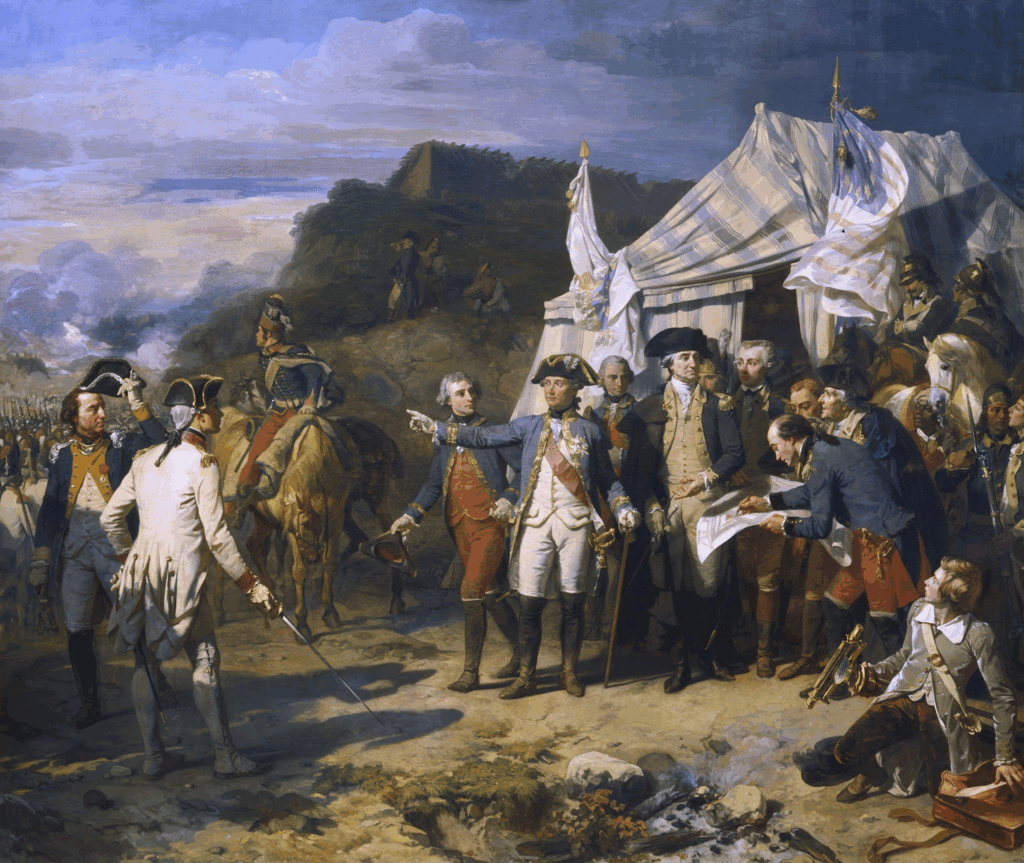The Battle of Yorktown: The Day the Revolution Was Won
By the autumn of 1781, the American Revolution had dragged on for six long years. Cities had been burned, armies scattered, and fortunes lost. Yet the question of independence remained unresolved. The British, under General Charles Cornwallis, had shifted their campaign to the South, hoping to rally Loyalist support and break the rebellion from its softer underbelly. But by September, Cornwallis found himself entrenched in the small Virginia tobacco port of Yorktown—unaware that a noose was slowly tightening around him.

The Trap Is Set
The plan to end the war was not born in Yorktown itself but in the minds of two unlikely collaborators: George Washington, the patient Virginian commander of the Continental Army, and the Comte de Rochambeau, the meticulous French general commanding French forces in America. Intelligence from French Admiral de Grasse revealed that a French fleet would sail from the Caribbean to the Chesapeake Bay in late summer. This meant a rare chance to trap Cornwallis by sea and land—if they could get there in time.
In a move that rivaled any great deception in military history, Washington feigned preparations to attack New York, convincing British commander Sir Henry Clinton that the city remained his primary target. Meanwhile, in late August, American and French troops began a blistering 450-mile march south from New York to Virginia—covering the distance in just over a month.
The Siege Begins
By late September, the trap had sprung. De Grasse’s fleet, 28 ships strong, had driven off the British navy at the Battle of the Capes, sealing off Yorktown from the sea. On land, nearly 17,000 Franco-American troops surrounded Cornwallis’s 8,000 men. Washington and Rochambeau directed the siege, systematically tightening the ring.
On October 6, under cover of darkness, the allies began digging their first parallel—a trench line that crept closer to British defenses. Cannon batteries roared to life on October 9, unleashing a storm of iron that shattered redoubts, splintered gun carriages, and set the town aflame. Washington himself fired the first American cannon, a symbolic act of personal vengeance after years of retreat and sacrifice.
The Night Assault
To break the British line, two key earthworks—Redoubt 9 and Redoubt 10—had to fall. On the night of October 14, Washington ordered simultaneous assaults. The Americans, led by a young and fiercely determined Alexander Hamilton, stormed Redoubt 10 with unloaded muskets, relying on bayonets to maintain silence until the final rush. In a matter of minutes, the redoubt was theirs. The French, attacking Redoubt 9, faced heavier resistance but seized it with equal valor.

The next day, allied artillery moved forward, pounding the now-compressed British defenses without mercy. Cornwallis’ position was untenable.
Surrender at Yorktown
On October 17, a white flag appeared. Negotiations began, and on October 19, 1781, Cornwallis’s army marched out to surrender. In a tragic turn of events, Cornwallis declared himself ill and dispatched his second-in-command, General Charles O’Hara, to deliver the sword. Washington, adhering to protocol, directed O’Hara to surrender it to his second-in-command, Major General Benjamin Lincoln—a symbolic reversal of the humiliation Lincoln had suffered at Charleston the year before.

As British drummers beat a slow march, legend has it their musicians played “The World Turned Upside Down.” Whether true or not, the symbolism was undeniable: the mightiest empire on earth had been brought low by a scrappy coalition of rebels and their European allies.
Aftermath
Yorktown did not immediately end the war—formal peace would not come until the Treaty of Paris in 1783—but it broke Britain’s will to continue. The cost of another campaign was too great, the chance of victory too slim. In London, political opposition to the war swelled, and negotiations began in earnest.
For Washington, Yorktown was the crowning moment of his military career, a vindication of his long game of endurance, alliances, and carefully timed strikes. For the young United States, it was proof that unity—between colonies, between nations—could achieve the impossible.
Yorktown was more than a battle. It marked a pivotal moment where the aspiration for independence transitioned into an inevitable reality, and the smoke of cannon fire dissipated to unveil a nascent nation poised for birth.

